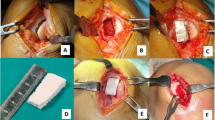Abstract
The aim of this study was to evaluate the potential of a biomimetic osteochondral scaffold for the treatment of osteochondritis dissecans (OCD). Twenty-seven consecutive patients, affected by knee OCD, were treated with the implantation of an acellular collagen-hydroxyapatite scaffold and prospectively evaluated at 4 years of follow-up. A significant improvement in all clinical scores was obtained at up to the final follow-up. This osteochondral scaffold is a valid option for knee OCD, showing a good and durable clinical outcome even for the treatment of large lesions.



Similar content being viewed by others
Bibliografia
Kocher MS, Tucker R, Ganley TJ (2006) Management of osteochondritis dissecans of the knee: current concepts review. Am J Sports Med 34(7):1181–1191
Linden B (1976) The incidence of osteochondritis dissecans in the condyles of the femur. Acta Orthop Scand 47(6):664–667
Crawford DC, Safra MR (2006) Osteochondritis dissecans of the knee. J Am Acad Orthop Surg 14(2):90–100
Cahill BR (1995) Osteochondritis dissecans of the knee: treatment of juvenile and adult form. J Am Acad Orthop Surg 3(4):237–247
Louisia S, Beaufils P, Katabi M, Robert H (2003) Transchondral drilling for osteochondritis dissecans of the medial condyle of the knee. Knee Surg Sports Traumatol Arthrosc 11(1):33–39
Detterline AJ, Goldstein JL, Rue JPH, Bach BR (2008) Evaluation and treatment of osteochondritis dissecans lesions of the knee. J Knee Surg 21(2):106–115
De Smet AA, Ilahi OA, Graf BK (1997) Untreated osteochondritis dissecans of the femoral condyles: predication of patient outcome using radiographic and MR findings. Skelet Radiol 26(8):463–467
Mizuta H, Nakamura E, Otsuka Y et al. (2001) Osteochondritis dissecans of the lateral femoral condyle following total resection of discoid lateral meniscus. Arthroscopy 7(6):608–612
Brittberg M, Winalski CS (2003) Evaluation of cartilage injuries and repair. J Bone Jt Surg, Am Vol 85-A(Suppl 2):58–69
Kon E, Delcogliano M, Filardo G, Marcacci M (2010) A novel nano-composite multi-layered biomaterial for treatment of osteochondral lesions: technique note and an early stability pilot clinical trial. Injury 41(7):693–701
ICRS cartilage injury evaluation package (2000) http://www.cartilage.org/Evaluation_Package/ICRS_Evaluation.pdf
Tegner Y, Lysholm J (1985) Rating systems in the evaluation of knee ligament injuries. Clin Orthop Relat Res 198:43–49
Trinh TQ, Harris JD, Flanigam DC (2012) Surgical management of juvenile osteochondritis dissecans of the knee. Knee Surg Sports Traumatol Arthrosc 20(12):2419–2429
Lim HC, Bae JH, Park YE et al. (2012) Long-term results of arthroscopy excision of unstable osteochondral lesions of the lateral femoral condyle. J Bone Jt Surg, Br Vol 94(2):185–189
Chambers HG, Shea KG, Anderson AF et al. (2012) American Academy of Orthopaedic Surgeons clinical practice guideline on: the diagnosis and treatment of osteochondritis dissecans. J Bone Jt Surg, Am Vol 94(14):1322–1324
Filardo G, Kon E, Di Martino A et al. (2011) Arthroscopic second-generation autologous chondrocyte implantation: a prospective 7-year follow-up study. Am J Sports Med 39(10):2153–2160
Berruto M, Delcogliano M, de Caro F et al. (2014) Treatment of large knee osteochondral lesions with a biomimetic scaffold: results of a multicenter study of 49 patients at 2-year follow-up. Am J Sports Med 42(7):1607–1617
Marcacci M, Filardo G, Kon E (2013) Treatment of cartilage lesions: what works and why? Injury 44(Suppl 1):S11–S15
Krishnan SP, Skinner JA, Carrington RW et al. (2006) Collagen-covered autologous chondrocyte implantation for osteochondritis dissecans of the knee: two to seven years results. J Bone Jt Surg, Br Vol 88(2):203–205
Steinhagen J, Bruns J, Deuretzbacher G et al. (2010) Treatment of osteochondritis dissecans of the femoral condyle with autologous bone grafts and matrix-supported autologous chondrocytes. Int Orthop 34(6):819–825
Filardo G, Kon E, Di Martino A et al. (2012) Arthroscopic second generation autologous chondrocytes implantation associated with bone grafting for the treatment of knee osteochondritis dissecans: results at 6 years. Knee 19(5):658–663
Ringraziamenti
Si ringrazia Elettra Pignotti per l’analisi statistica.
Author information
Authors and Affiliations
Corresponding author
Ethics declarations
Conflitto di interesse
Gli autori Alessia Cavicchioli e Federica Balboni dichiarano di non aver alcun conflitto di interesse. L’autore Elizaveta Kon ha ricevuto un finanziamento dall’azienda Finceramica, Italia, Fidia, Italia, CartiHeal (2009) Ltd (Israele). L’autore Maurilio Marcacci ha ricevuto un finanziamento dall’azienda Finceramica, Faenza SpA (Italia). L’autore Giuseppe Filardo ha ricevuto un finanziamento dall’azienda Finceramica, Faenza SpA (Italia), Fidia Farmaceutici Spa (Italia), CartiHeal (2009) Ltd (Israele).
Consenso informato e conformità agli standard etici
Tutte le procedure descritte nello studio e che hanno coinvolto esseri umani sono state attuate in conformità alle norme etiche stabilite dalla dichiarazione di Helsinki del 1975 e successive modifiche. Il consenso informato è stato ottenuto da tutti i pazienti inclusi nello studio.
Rights and permissions
About this article
Cite this article
Cavicchioli, A., Kon, E., Filardo, G. et al. Trattamento dell’osteocondrite dissecante del ginocchio con scaffold osteocondrale biomimetico. LO SCALPELLO 30, 121–126 (2016). https://doi.org/10.1007/s11639-016-0159-7
Published:
Issue Date:
DOI: https://doi.org/10.1007/s11639-016-0159-7




